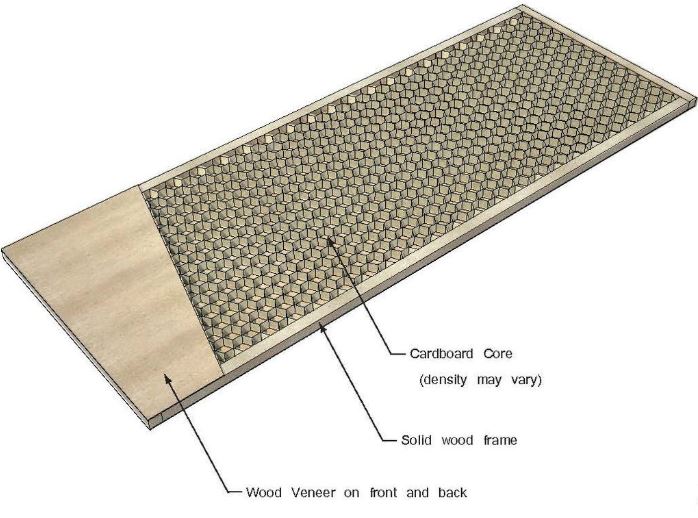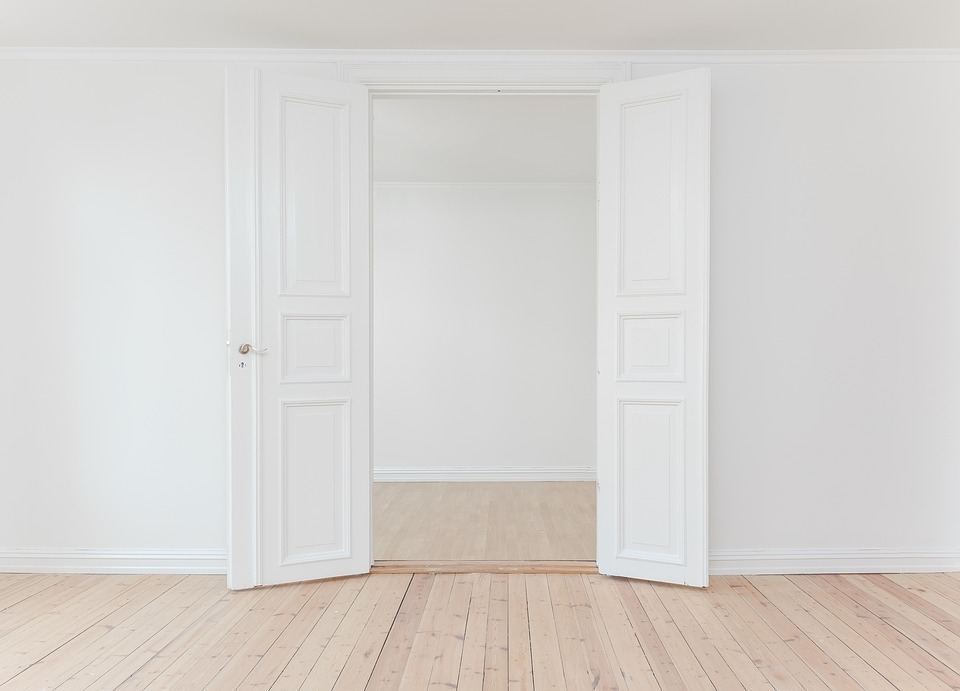Homes are not all made with the same types of doors. Most people take their doors for granted without really thinking about what lies within their core. Some doors are more suitable for certain homes than others. In the end, it depends on what a homeowner wants and needs as far as their doors are concerned. At Men Behaving Handy our handyman Perth service is expert in door installations and can advise what is best for your situation.
Inside the average household, you’ll typically find fully flush doors which are used with all the rooms. These are doors with no whistles, bells, or any other fancy features like you’d find on your front and rear doors. The only extra feature on the door is the handle itself.
However, this doesn’t mean that all flush doors have the same characteristics. Some flush doors are made from different materials and of different sizes. Their heights and widths must accommodate the dimensions of the corresponding doorways in the home. While choosing the right dimensions might be easy for most people to do, the real challenge comes with choosing the right core material for the flush door. We’ll go over those choices now.
Solicore Doors
The purpose of Solicore doors is to reduce the noise which comes from rooms. Solicore doors are able to reduce noise because their core contains a particle board that absorbs it. The core has moisture resistant properties as well.
Due to all these wonderful benefits, Solicore doors are appropriate to use for rooms in any environment. You can use them in homes, hospitals, schools, and offices. There are several options when it comes to the face material of the Solicore doors. Some of these materials include Tempered Hardboard, Primecoat MDF, Tassie Oak, A’bond Paint Ply, and SPM.
Honeycomb Doors
The core of honeycomb flush doors is made from high-density cells. This cellular nature of the core gives the door stability, functionality, and lighter weight. Honeycomb is a versatile door option which is also quite affordable for the average homeowner. You can purchase a multi-fold or bi-fold version of the honeycomb core flush door. In addition, there are several different sizes available too.
When choosing the face material, there are many options available like commercial prime coat, prime coat MDF, SPM, and light commercial prime coat. The external door material options include SPM, Tempered Hardboard, and A’Bond Paint Ply.

Solid Core Doors
If you’re looking for a door which literally has a solid interior, then you will love solid core doors. Their core consists of pine blockboard to give it this solidness. Also, the solid blockboard nature of the core allows you to cut the board in order to modify the size. That way, you can make it fit better in certain doorways which may be uneven. The exterior material options include SPM, Tempered Hardboard, and A’bond Paint Ply. If you’re looking to apply a high gloss finish, then it is not recommended for solid core doors because their core might be seen if you do.
There is no right or wrong choice here. You can choose the solid core, solicore, or honeycomb core and it will be just fine if that’s what you want. If your flush door caters to your appeal and needs, then it is a good choice. There are so many options out there, so there is certainly something for everyone. But you need to educate yourself on how each type of door can be used to the best of its potential. This will help you make the right choice when shopping for a door for your home or building.
Poly Insulted Core or Honeycomb Core? Which one is better?
It is always important to have a strong interior core for your door. After all, why would you want a weak door where sound can easily pass through it? The classic hollow-core doors may be cheap, but they don’t absorb sound or last very long either. That is why the industry standard for the interior of doors today is honeycomb cores. But why not go with an alternative choice like a poly insulated core? What makes these doors differ from each other? Do they provide the same performance?
Let’s examine the properties of each one:
1) Insulation
When you want to have different temperatures in different rooms, then your door needs to provide good insulation for these rooms. If you look at the core of a honeycomb door, it is basically 2 veneers with a piece of fiberboard or cardboard in between them. This is how the door receives its structural support. However, there is still extra air space in this area which is not filled. As a result, the insulation is not so great with the honeycomb core door.
But if you look at the core of a poly insulated door, the area which normally has extra air space is now filled with polystyrene. Without that air space, the core does a much better job of insulating the room from exterior temperatures trying to seep through. Therefore, a poly insulated core door provides much better insulation than a honeycomb core door.
2) Blocking Winds
Doors are traditionally supposed to block winds and drafts from getting through them. Depending on the doors, some block these elements better than others. Sometimes you may want an interior door to separate zones which have various air pressure. If it’s an exterior door, then you’ll obviously want to block the outside winds from getting into the building. Well, a honeycomb core has an air space which allows winds or drafts to pass through it to the opposite side. Once this happens, it will be nearly impossible to heat or cool the rooms in your building because the winds and drafts interfere with it. For this reason, you need to use a poly insulated core door instead because it features a solid foam core which can block winds and drafts from passing through it. That way, inside air cannot get out and outside air cannot get in. The temperatures of your rooms stay at the temperature you set them too on your thermostat.
3) Sound Management
A lot of different industries are focusing more on sound control. For instance, hospitals have been looking for ways to provide their patients with a quieter environment to sleep in. So, they’ve integrated sound-blocking technology into the patients’ rooms. Schools are also using this technology so that the sounds from one classroom don’t distract the students in another classroom nearly.
At some point, we’ve all stood in front of a closed door and were able to hear the sounds being made on the other side of it. More than likely, it was a honeycomb core door which has all that dead air space inside. That is why sounds can get through the middle of the core. However, the newer poly insulated doors are much better at reducing the intensity of sound waves because all that dead air space is filled with foam. The foam reduces the sounds considerably from getting through. Once again, the poly insulated door is superior.
Okay, so is there any advantage to purchasing a honeycomb core door? Unless you’re looking for a more affordable and budget-friendly priced door, there really is no reason to purchase one. The polystyrene core material of the poly insulated doors makes them more beneficial in every way except for the higher price. If you’re not afraid to invest a little money in a good quality door, then go with a poly insulated door. It will actually save you money in the long run because your utility bills will be lowered due to all the energy savings.
Hollow Core vs. Solid Core
Choosing a door with the right core can get confusing because you don’t actually get to see the interior up close. The core is covered by the external material that we see on the outer surface. That is why people tend to get so preoccupied with choosing the right design and style for their door. They often neglect to think about the door’s construction and what’s on the inside of it. The construction is what truly affects the cost, function, and overall lifespan of the door.
In most cases, exterior doors are constructed from solid wood material. But the interior doors tend to be more versatile. Since there are more inside doors than outside doors, homeowners like to take the cheaper route by choosing hollow-core doors for their interior. But is that really the best idea? Let’s look.
Cost Effectiveness
Most modern homes are constructed with hollow-core doors on the inside. It is a popular option amongst builders because of their inexpensive cost. Holly-core doors consist of thin veneers made from premium quality wood. However, the core is made from plastic or a honeycombed cardboard material which is placed inside a wooden frame. This gives the door some stability, but not as much as a solid-core would.
Hollow-core doors are lighter in weight which makes them easier and cheaper to install. Between the material and installation costs, choosing hollow-core interior doors can save you hundreds or even thousands of dollars.
Don’t forget, there are some other advantages to choosing hollow-core doors besides their affordable cost. For instance, seasonal changes outside won’t affect the humidity level on the inside. They’re also very stable and can easily be trimmed to accommodate unusually shaped door frames.
Of course, their hollowness makes them slightly flimsy. They also cannot block sounds very well or stop fires from spreading. So, these are considerations to make too.

An Investment in Quality
Solid-core doors are heavier doors which do a better job of blocking sound and insulating rooms. The core of these doors is made of MDF, which is a specially engineered wood with fine veneer attached to it on top. People can use these doors as interior doors or exterior doors.
There are certain versions of solid-core doors which are made to look like real wood. However, they have no veneers included with them. The benefit of these versions is they don’t warp as time goes on.
Another reason to use solid-core doors is to prevent the spreading of fires. Since their cores often use engineered wood with a higher density, they’re able to be heavier and thicker than just solid wood core doors. It often requires two people to fit a door like this because of its weight. After the job is done, the solid-core doors will provide more privacy and safety on the inside and/or outside of your home.
Mixed Solutions
If you are on a budget but want to have some safety and privacy, then think about using both solid-core doors and hollow-core doors in your home. Hollow-core is better for areas like storage rooms and closets. Solid-core is better for rooms, entrances, and exits.
Get Our Recommendation
No one expects you to be an expert of doors. If all these different options and door specifications seem confusing, then contact us to clear up your confusion. Our professional door installers have decades of experience fitting doors in virtually all areas of homes. They can recommend the best doors to accommodate your budget and needs.





